
The East Broad Street Historic District in Columbus, Ohio is a historic district that was listed on the National Register of Historic Places in 1987. The district includes the section of East Broad Street from Ohio Avenue on the west to Monypenny Street on the east. It includes lavish residences, some converted to offices.
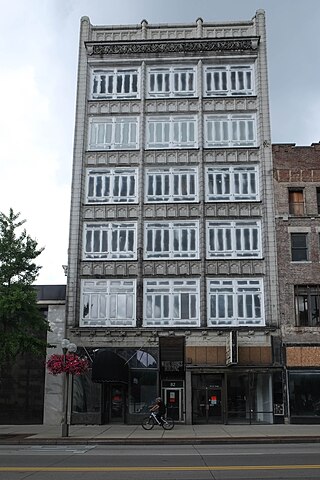
The White–Haines Building, also known as C. O. Haines Optical Company Building, is a historic building located at 82 North High Street in Downtown Columbus, Ohio. The building is part of the High and Gay Streets Historic District on the National Register of Historic Places.

The Toledo and Ohio Central Railroad Station, today named Station 67, is a union meeting space and event hall located in Franklinton, near Downtown Columbus, Ohio. Built by the Toledo and Ohio Central Railroad from 1895 to 1896, it served as a passenger station until 1930. It served as an office and shelter for Volunteers of America from 1931 to 2003, and has been the headquarters of International Association of Fire Fighters Local 67, a firefighters' union, since 2007. The building was placed on the National Register of Historic Places in 1973. During its history, the building has experienced fires and floods, though its relatively few owners have each made repairs and renovations to preserve the building's integrity. The building is the last remaining train station in Columbus.

Capitol Square is a public square in Downtown Columbus, Ohio. The square includes the Ohio Statehouse, its 10-acre (4.0 ha) Capitol Grounds, as well as the buildings and features surrounding the square. The Capitol Grounds are surrounded on the north and west by Broad and High Streets, the main thoroughfares of the city since its founding, forming the city's 100 percent corner. The grounds are surrounded by 3rd Street on the east and State Street on the south. The oldest building on Capitol Square, the Ohio Statehouse, is the center of the state government, and in the rough geographic center of Capitol Square, Columbus, and Ohio.
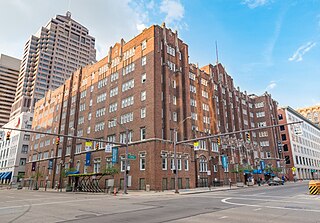
The Downtown YMCA is a historic former YMCA building in Downtown Columbus, Ohio. It was the largest YMCA resident facility in the United States. It was listed on the National Register of Historic Places in 1993. The seven-story building was designed in the Jacobethan Revival and Late Gothic Revival styles by Chicago architecture firm Shattuck & Layer.
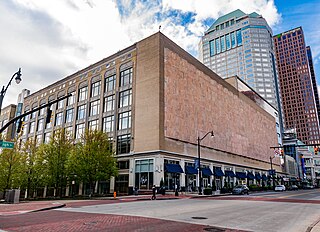
The Lazarus Building is a commercial building in Downtown Columbus, Ohio. It was the flagship store of the F&R Lazarus & Company, a department store founded nearby in 1851. The building, completed in 1909, housed the Lazarus department store until 2004, one year before its brand was retired. The building currently houses numerous state and county offices, the Ohio State University Urban Arts Space, and restaurants and a bank branch in its storefronts on High Street.
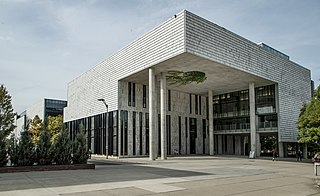
The architecture of Columbus, Ohio is represented by numerous notable architects' works, individually notable buildings, and a wide range of styles. Yost & Packard, the most prolific architects for much of the city's history, gave the city much of its eclectic and playful designs at a time when architecture tended to be busy and vibrant.

The Columbus Board of Trade Building was a historic building on Capitol Square in Downtown Columbus, Ohio. The building was built in 1889 for the present-day Columbus Chamber of Commerce, and was designed by Elah Terrell and Joseph W. Yost. It became vacant in 1964 and was demolished five years later. The Rhodes State Office Tower sits on the site today.
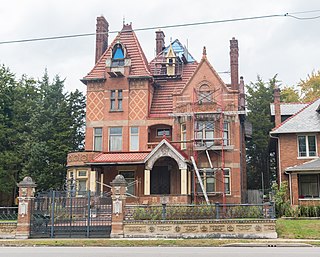
The Charles Frederick Myers house is a historic private residence in the Franklin Park neighborhood of Columbus, Ohio. The house was built in 1896 in an eclectic style. It was added to the Columbus Near East Side District in 1978, and the Bryden Road District in 1990.

Milo Arts is a community arts center and former public school building in the Milo-Grogan neighborhood of Columbus, Ohio. The arts center was founded in 1988, and was considered a radical concept at the time. It is the longest-lasting artist live-work space in Columbus.

The 1840 Franklin County Courthouse was the first permanent courthouse of Franklin County, Ohio in the United States. The building, located in the county seat of Columbus, stood from 1840 to 1884. The building was replaced with another county courthouse in 1887, and after its demise, that courthouse was replaced with Dorrian Commons Park, open from 1976 to 2018; the courthouse moved to a new building nearby. The site is now planned to host the Franklin County Municipal Court.
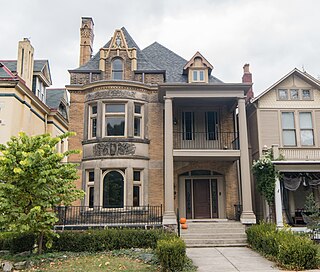
The Joseph Warren Yost House is a historic house in Columbus, Ohio. It was added to the Columbus Near East Side District in 1978, and the Bryden Road District in 1990.

The Broad-Brunson Place Condominiums is a set of condominium units in the Woodland Park neighborhood of Columbus, Ohio. The condominiums were listed on the Columbus Register of Historic Properties in 1984
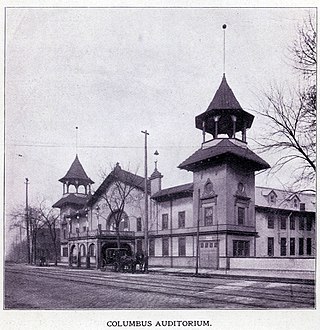
The Columbus Auditorium was the name of two mixed-use venues in Columbus, Ohio. The first was extant from 1897 to 1910; the second stood from 1927 to 1992. For the last 50 years of its existence, the auditorium building was known as the Lazarus Annex, an expansion of the flagship Lazarus department store.
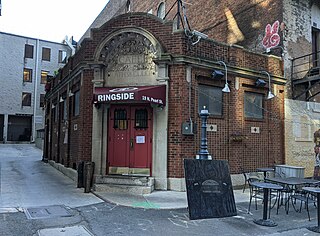
Ringside Café is a restaurant and bar in Downtown Columbus, Ohio. The restaurant is considered the oldest bar or restaurant in Downtown Columbus, having opened in 1897 and operated continuously since then. The restaurant has always been an attraction of politicians, lawyers, reporters, and lobbyists, given its proximity to the Ohio Statehouse, Columbus City Hall, and other government buildings.
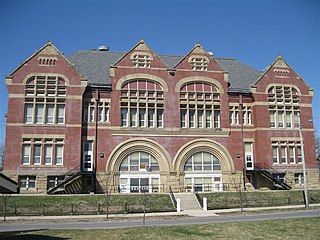
Medary Avenue Elementary School is a school building in the Old North Columbus neighborhood of Columbus, Ohio. The building was constructed in 1892 and was designed by prolific school architect David Riebel.

Beck Street School is a school building in the Schumacher Place neighborhood of Columbus, Ohio. The building was constructed in 1884 and was designed by prolific school architect David Riebel. The school was recognized as one of Columbus's historically significant schools, in a 2002 report by the Columbus Landmarks Foundation.

The Fair Avenue Elementary School is a historic school building in the Franklin Park neighborhood of Columbus, Ohio. The building contributes to the Columbus Near East Side District, on the National Register of Historic Places. It was built in the Richardsonian Romanesque style in 1890, having been designed by prolific Columbus architect Frank Packard. The building, originally housing a school as part of the Columbus Public School District, currently houses one of three campuses of the A+ Arts Academy.

Avondale Elementary School is a historic school building in the Franklinton neighborhood of Columbus, Ohio. The building was built in the Richardsonian Romanesque style in 1893, having been designed by prolific Columbus architect David Riebel.


















